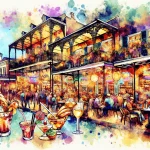New Orleans captivates visitors with its energetic ambiance and distinct character. However, many tourists wonder about the safety aspect of this popular destination. The truth is, like any major city, New Orleans experiences crime, but with proper precautions and awareness, you can enjoy a secure and enjoyable visit.
In This Article
TL;DR
- Tourist hotspots are generally secure, but staying vigilant, especially at night, is crucial.
- Safety levels vary across neighborhoods, so being aware and taking precautions is essential.
- Immersing in the local culture and community can enhance safety and overall experience.
Understanding Safety in New Orleans
The Reality of Crime in New Orleans
While New Orleans‘ crime rates surpass the national average, most violent crimes occur away from tourist areas. According to the latest FBI statistics, New Orleans ranks among the top 10 cities in the United States for violent crime rates. However, these numbers can be misleading, as they don’t account for the millions of visitors the city receives each year.
The types of crimes tourists are most likely to encounter are petty theft, such as pickpocketing or bag snatching, and opportunistic crimes like muggings or robberies. Violent crimes against tourists are relatively rare, but it’s still important to exercise caution and be aware of your surroundings.
High-Risk vs. Low-Risk Areas
High-Risk Areas:
- Central City: This neighborhood, located just northwest of the French Quarter, has a high crime rate and should be avoided by tourists.
- New Orleans East: This area, located east of the city center, is known for its high crime rates and lack of tourist attractions.
- Certain parts of the 9th Ward: While some areas of this neighborhood have been revitalized, others remain high-risk due to crime and poverty.
Low-Risk Areas:
- The French Quarter: This iconic neighborhood is heavily patrolled by police and is generally safe for tourists, especially during the day and early evening hours.
- The Garden District: This upscale residential area is known for its beautiful antebellum mansions and is considered one of the safest neighborhoods in New Orleans.
- The Warehouse District: This trendy area, located just outside the French Quarter, is home to many restaurants, galleries, and museums, and is considered safe for visitors.
Practical Safety Tips for Travelers
Before You Go
Research your accommodations thoroughly and choose a reputable hotel or vacation rental in a safe area. It’s also a good idea to purchase travel insurance and have emergency contact information readily available.
Navigating the City Safely
When it comes to transportation, taxis, ride-sharing services, and the iconic streetcars are generally safe options. However, it’s best to avoid walking alone at night, especially in deserted areas. If you plan to enjoy New Orleans’ famous nightlife, consider joining a guided tour or traveling in a group.
Cultural events and festivals, such as Mardi Gras, are a big part of the New Orleans experience. While these events are generally safe, it’s important to be aware of your surroundings and avoid becoming overly intoxicated or carrying valuables in crowded areas.
Personal Safety Measures
To protect your belongings from theft, keep valuables out of sight and consider using anti-theft bags or money belts. Be wary of common scams, such as someone offering to “help” you with your luggage or asking for money for a fake charity.
In case of an emergency, have the numbers for local law enforcement and your embassy or consulate readily available. It’s also a good idea to familiarize yourself with the location of the nearest hospital or clinic.
Engaging with New Orleans Safely
Embracing the Local Culture
One of the best ways to enhance your safety in New Orleans is to immerse yourself in the local culture. By understanding local customs and traditions, you’ll be better equipped to navigate the city and avoid potential misunderstandings or conflicts.
Some recommended cultural experiences that are both safe and enriching include attending a jazz performance at one of the city’s iconic music venues, taking a cooking class to learn about Creole and Cajun cuisine, or joining a guided walking tour of the French Quarter.
Community and Safety
The local community plays a vital role in ensuring the safety of visitors to New Orleans. Many neighborhoods have active neighborhood watch programs and close-knit communities that look out for one another.
As a visitor, you can contribute to a safe and positive environment by being respectful of local customs and traditions, supporting local businesses, and engaging with the community in a respectful and friendly manner.
Safety During Major Events
New Orleans is famous for its annual Mardi Gras celebration, which attracts millions of visitors each year. While Mardi Gras is generally a safe and festive event, it’s important to exercise caution in crowded areas and be aware of your surroundings.
Other major events in New Orleans, such as the New Orleans Jazz and Heritage Festival and the French Quarter Festival, also require visitors to take precautions. Be sure to stay hydrated, wear comfortable shoes, and avoid carrying valuables in crowded areas.
Additional Resources
Official Safety Guides and Resources
The City of New Orleans provides a comprehensive visitor safety guide on its website, which includes tips for staying safe, emergency contact information, and updates on any safety advisories or alerts.
Additionally, the New Orleans Convention and Visitors Bureau offers a variety of resources for visitors, including a safety guide and information on local laws and customs.
Expert Consultations
For expert advice on staying safe in New Orleans, consider consulting with local law enforcement or community leaders. Many neighborhoods have active neighborhood watch programs or community organizations that can provide valuable insights and recommendations.
Historical Perspective on Safety
While New Orleans has faced its share of challenges when it comes to safety and crime, the city has made significant strides in recent years. Major events, such as Hurricane Katrina, have shaped the city’s approach to safety and emergency preparedness, and ongoing efforts by local authorities and community organizations have helped to improve safety conditions in many neighborhoods.
By understanding the historical context and ongoing efforts to improve safety, visitors can gain a deeper appreciation for the resilience and spirit of the city and its residents.
New Orleans is a city like no other, with a rich cultural heritage, vibrant music scene, and world-renowned cuisine. While it’s important to exercise caution and take appropriate safety measures, visitors who embrace the local culture and engage with the community can have a truly unforgettable and safe experience in this unique and captivating city.






